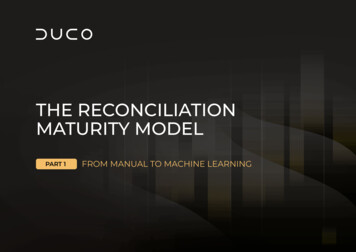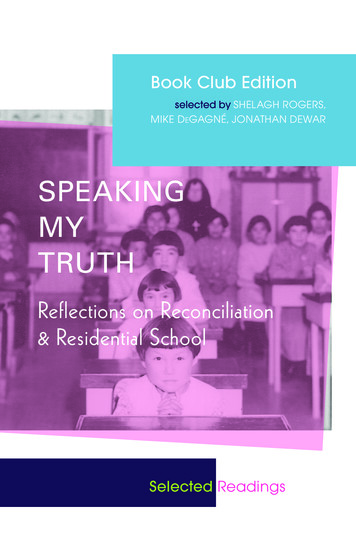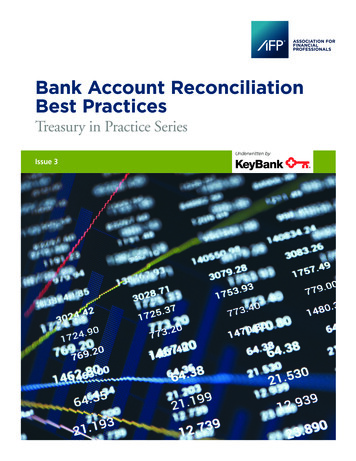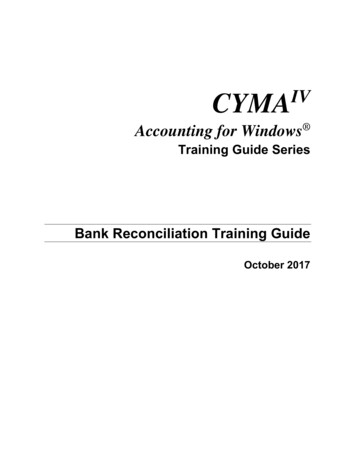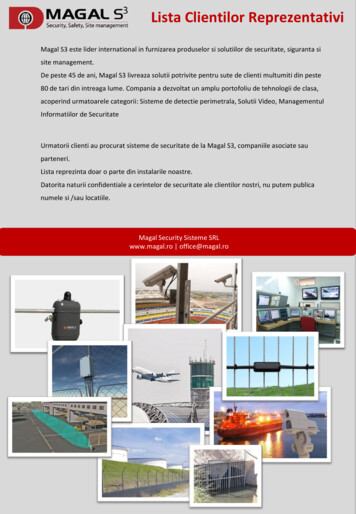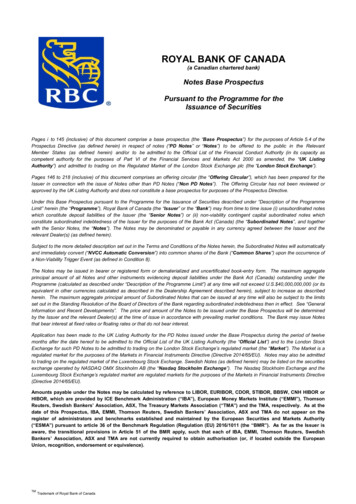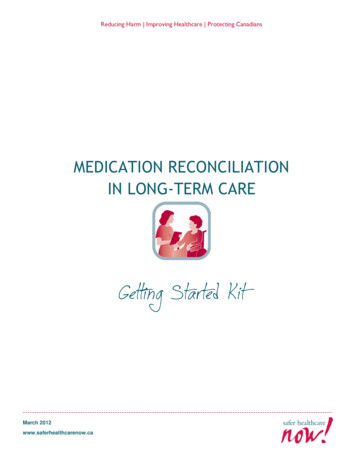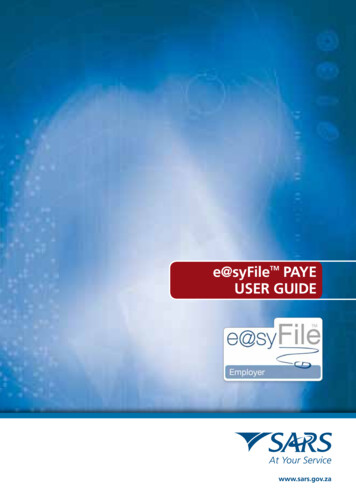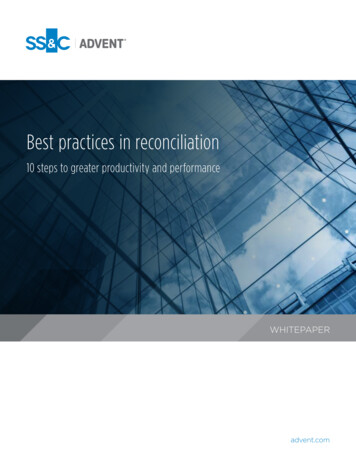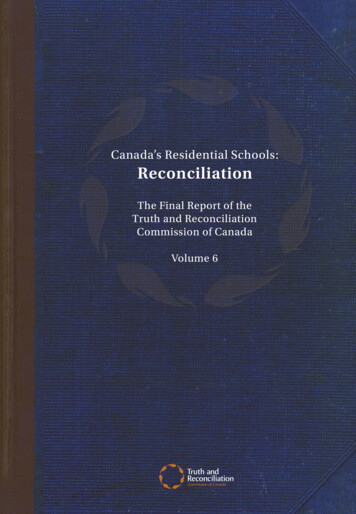
Transcription
Canada’s Residential Schools:ReconciliationThe Final Report of theTruth and ReconciliationCommission of CanadaVolume 6
Canada’s Residential SchoolsVolume 6
Canada’s Residential Schools:ReconciliationThe Final Report of theTruth and ReconciliationCommission of CanadaVolume 6Published for theTruth and Reconciliation CommissionbyMcGill-Queen’s University PressMontreal & Kingston London Chicago
This report is in the public domain.Anyone may, without charge or request for permission, reproduce all or part of this report.2015Truth and Reconciliation Commission of CanadaWebsite: www.trc.caISBN 978-0-7735-4661-5 (v. 6 : bound).ISBN 978-0-7735-4662-2 (v. 6 : paperback).Printed in Canada on acid-free paperAn index to this volume of the final report is available online. Please visit http://nctr.ca/trc reports.phpLibrary and Archives Canada Cataloguing in PublicationTruth and Reconciliation Commission of Canada[Canada’s residential schools]Canada’s residential schools : the final report of the Truth and Reconciliation Commission of Canada.(McGill–Queen’s Native and northern series ; 80–86)Includes bibliographical references and index.Contents: v. 1. The history. Part 1, origins to 1939 — The history. Part 2, 1939 to 2000 — v. 2. The Inuit andnorthern experience — v. 3. The Métis experience — v. 4. The missing children and unmarked burialsreport — v. 5. The legacy — v. 6. ReconciliationIssued in print and electronic formats.ISBN 978-0-7735-4649-3 (v. 1, pt. 1 : bound).ISBN 978-0-7735-4651-6 (v. 1, pt. 2 : bound).ISBN 978-0-7735-4653-0 (v. 2 : bound).ISBN 978-0-7735-4655-4 (v. 3 : bound).ISBN 978-0-7735-4657-8 (v. 4 : bound).ISBN 978-0-7735-4659-2 (v. 5 : bound).ISBN 978-0-7735-4661-5 (v. 6 : bound).ISBN 978-0-7735-9817-1 (v. 1, pt. 1 : ePDF).ISBN 978-0-7735-9819-5 (v. 1, pt. 2 : ePDF).ISBN 978-0-7735-9821-8 (v. 2 : ePDF).ISBN 978-0-7735-9823-2 (v. 3 : ePDF).ISBN 978-0-7735-9825-6 (v. 4 : ePDF).ISBN 978-0-7735-9827-0 (v. 5 : ePDF).ISBN 978-0-7735-9829-4 (v. 6 : ePDF).ISBN 978-0-7735-4650-9 (v. 1, pt. 1 : paperback).ISBN 978-0-7735-4652-3 (v. 1, pt. 2 : paperback).ISBN 978-0-7735-4654-7 (v. 2 : paperback).ISBN 978-0-7735-4656-1 (v. 3 : paperback).ISBN 978-0-7735-4658-5 (v. 4 : paperback).ISBN 978-0-7735-4660-8 (v. 5 : paperback).ISBN 978-0-7735-4662-2 (v. 6 : paperback).ISBN 978-0-7735-9818-8 (v.1, pt. 1 : ePUB).ISBN 978-0-7735-9820-1 (v. 1, pt. 2 : ePUB).ISBN 978-0-7735-9822-5 (v. 2 : ePUB).ISBN 978-0-7735-9824-9 (v. 3 : ePUB).ISBN 978-0-7735-9826-3 (v. 4 : ePUB).ISBN 978-0-7735-9828-7 (v. 5 : ePUB).ISBN 978-0-7735-9830-0 (v. 6 : ePUB)1. Native peoples—Canada—Residential schools. 2. Native peoples—Education—Canada.3. Native peoples—Canada—Government relations. 4. Native peoples—Canada—Social conditions.5. Native peoples—Canada—History. I. Title. II. Series: McGill–Queen’s Native and northern series ; 80–86E96.5.T78 2016971.004’97C2015-905971-2C2015-905972-0
ContentsIntroduction.31. The challenge of reconciliation.192. Indigenous law: Truth, reconciliation, and access to justice.453. From apology to action: Canada and the churches.814. Education for reconciliation.1175. Public memory: Dialogue, the arts, and commemoration.1576. We are all Treaty people: Canadian society and reconciliation.193Calls to action.223Notes.243Bibliography.267
Canada’s Residential SchoolsVolume 6
IntroductionTo some people, “reconciliation” is the re-establishment of a conciliatory state.However, this is a state that many Aboriginal people assert has never existedbetween Aboriginal and non-Aboriginal people. To others, “reconciliation,” inthe context of Indian residential schools, is similar to dealing with a situation of familyviolence. It is about coming to terms with events of the past in a manner that overcomes conflict and establishes a respectful and healthy relationship among peoplegoing forward. It is in the latter context that the Truth and Reconciliation Commissionof Canada (trc) has approached the question of reconciliation.To the Commission, “reconciliation” is about establishing and maintaining a mutually respectful relationship between Aboriginal and non-Aboriginal peoples in thiscountry. For that to happen, there has to be awareness of the past, acknowledgementof the harm that has been inflicted, atonement for the causes, and action to changebehaviour.We are not there yet. The relationship between Aboriginal and non-Aboriginalpeoples is not a mutually respectful one. But we believe we can get there, and webelieve we can maintain it. Our ambition is to show how we can do that.In 1996, the Report of the Royal Commission on Aboriginal Peoples urged Canadiansto begin a national process of reconciliation that would have set the country on a boldnew path, fundamentally changing the very foundations of Canada’s relationship withAboriginal peoples. Much of what the Royal Commission had to say has been ignoredby government; a majority of its recommendations were never implemented. But thereport and its findings opened people’s eyes and changed the conversation about thereality for Aboriginal people in this country.In 2015, as the Truth and Reconciliation Commission of Canada wraps up its work,the country has a rare second chance to seize a lost opportunity for reconciliation. Welive in a twenty-first-century global world. At stake is Canada’s place as a prosperous,just, and inclusive democracy within that global world. At the trc’s first National Eventin Winnipeg, Manitoba, in 2010, residential school Survivor Alma Mann Scott said,The healing is happening—the reconciliation. I feel that there’s some hope forus not just as Canadians, but for the world, because I know I’m not the only one.I know that Anishinaabe people across Canada, First Nations, are not the only
4 Truth & Reconciliation Commissionones. My brothers and sisters in New Zealand, Australia, Ireland—there’s different areas of the world where this type of stuff happened. I don’t see it happening in a year, but we can start making changes to laws and to education systems. so that we can move forward.1Reconciliation must support Aboriginal peoples as they heal from the destructivelegacies of colonization that have wreaked such havoc in their lives. But it must doeven more. Reconciliation must inspire Aboriginal and non-Aboriginal peoples totransform Canadian society so that our children and grandchildren can live togetherin dignity, peace, and prosperity on these lands we now share.The urgent need for reconciliation runs deep in Canada. Expanding public dialogue and action on reconciliation beyond residential schools will be critical in thecoming years. Although some progress has been made, significant barriers to reconciliation remain. The relationship between the federal government and Aboriginalpeoples is deteriorating. Instead of moving towards reconciliation, there have beendivisive conflicts over Aboriginal education, child welfare, and justice. The daily newshas been filled with reports of controversial issues ranging from the call for a nationalinquiry on violence towards Aboriginal women and girls to the impact of the economicdevelopment of lands and resources on Treaties and Aboriginal title and rights.2 Thecourts continue to hear Aboriginal rights cases, and new litigation has been filed bySurvivors of day schools not covered under the Indian Residential Schools SettlementAgreement, as well as by victims of the “Sixties Scoop.”3 The promise of reconciliation,which seemed so imminent back in 2008 when the prime minister, on behalf of allCanadians, apologized to Survivors, has faded.Too many Canadians know little or nothing about the deep historical roots ofthese conflicts. This lack of historical knowledge has serious consequences for FirstNations, Inuit, and Métis peoples, and for Canada as a whole. In government circles,it makes for poor public policy decisions. In the public realm, it reinforces racist attitudes and fuels civic distrust between Aboriginal peoples and other Canadians.4 Toomany Canadians still do not know the history of Aboriginal peoples’ contributions toCanada, or understand that by virtue of the historical and modern Treaties negotiatedby our government, we are all Treaty people. History plays an important role in reconciliation; to build for the future, Canadians must look to, and learn from, the past.As Commissioners, we understood from the start that although reconciliation couldnot be achieved during the trc’s lifetime, the country could and must take ongoingpositive and concrete steps forward. Although the Commission has been a catalystfor deepening our national awareness of the meaning and potential of reconciliation,it will take many heads, hands, and hearts, working together, at all levels of society tomaintain momentum in the years ahead. It will also take sustained political will at alllevels of government and concerted material resources.
Introduction 5The thousands of Survivors who publicly shared their residential school experiences at trc events in every region of this country have launched a much-neededdialogue about what is necessary to heal themselves, their families, their communities, and the nation. Canadians have much to gain from listening to the voices, experiences, and wisdom of Survivors, Elders, and Traditional Knowledge Keepers—andmuch more to learn about reconciliation. Aboriginal peoples have an important contribution to make to reconciliation. Their knowledge systems, oral histories, laws, andconnections to the land have vitally informed the reconciliation process to date, andare essential to its ongoing progress.At a Traditional Knowledge Keepers Forum sponsored by the trc, AnishinaabeElder Mary Deleary spoke about the responsibility for reconciliation that bothAboriginal and non-Aboriginal people carry. She emphasized that the work of reconciliation must continue in ways that honour the ancestors, respect the land, andrebalance relationships.I’m so filled with belief and hope because when I hear your voices at the table,I hear and know that the responsibilities that our ancestors carried . are stillbeing carried . [E]ven through all of the struggles, even through all of what hasbeen disrupted . we can still hear the voice of the land. We can hear the careand love for the children. We can hear about our law. We can hear about ourstories, our governance, our feasts, [and] our medicines. We have work to do.That work we are [already] doing as [Aboriginal] peoples. Our relatives who havecome from across the water [non-Aboriginal people], you still have work to do onyour road. The land is made up of the dust of our ancestors’ bones. And so toreconcile with this land and everything that has happened, there is much workto be done . in order to create balance.5At the Victoria Regional Event in 2012, Survivor Archie Little said,[For] me reconciliation is righting a wrong. And how do we do that? All thesepeople in this room, a lot of non-Aboriginals, a lot of Aboriginals that probablydidn’t go to residential school; we need to work together. My mother had ahigh standing in our cultural ways. We lost that. It was taken away. And I thinkit’s time for you non-Aboriginals . to go to your politicians and tell them that wehave to take responsibility for what happened. We have to work together.6The Reverend Stan McKay of the United Church, who is also a Survivor, believesthat reconciliation can happen only when everyone accepts responsibility for healingin ways that foster respect.[There must be] a change in perspective about the way in which Aboriginalpeoples would be engaged with Canadian society in the quest for reconciliation.[We cannot] perpetuate the paternalistic concept that only Aboriginal peoplesare in need of healing. The perpetrators are wounded and marked by history in
6 Truth & Reconciliation Commissionways that are different from the victims, but both groups require healing. Howcan a conversation about reconciliation take place if all involved do not adopt anattitude of humility and respect? . We all have stories to tell and in order to growin tolerance and understanding we must listen to the stories of others.7Over the past five years, the Truth and Reconciliation Commission of Canada hasurged Canadians not to wait until its final report was issued before contributing to thereconciliation process. We have been encouraged to see that across the country, manypeople have been answering that call.The youth of this country are taking up the challenge of reconciliation. Aboriginaland non-Aboriginal youth who attended trc National Events made powerful statements about why reconciliation matters to them. At the Alberta National Eventin Edmonton in March 2014, an Indigenous youth spoke on behalf of a nationalIndigenous and non-Indigenous collaboration called the 4Rs Youth Movement.Jessica Bolduc said,We have re-examined our thoughts and beliefs around colonialism, and havemade a commitment to unpack our own baggage, and to enter into a new relationship with each other, using this momentum, to move our country forward, inlight of the 150th anniversary of the Confederation of Canada in 2017.At this point in time, we ask ourselves, “What does that anniversary mean for us,as Indigenous youth and non-Indigenous youth, and how do we arrive at thatday with something we can celebrate together?” . Our hope is that, one day, wewill live together, as recognized nations, within a country we can all be proud of.8In 2013, at the British Columbia National Event in Vancouver, where over 5,000elementary and secondary school students attended Education Day, several non-Aboriginal youth talked about what they had learned. Matthew Meneses said, “I’llnever forget this day. This is the first day they ever told us about residential schools. IfI were to see someone who’s Aboriginal, I’d ask them if they can speak their languagebecause I think speaking their language is a pretty cool thing.” Antonio Jordao said, “Itmakes me sad for those kids. They took them away from their homes—it was torture,it’s not fair. They took them away from their homes. I don’t agree with that. It’s reallywrong. That’s one of the worst things that Canada did.” Cassidy Morris said, “It’s goodthat we’re finally learning about what happened.” Jacqulyn Byers told us, “I hope thatevents like this are able to bring closure to the horrible things that happened, and thata whole lot of people now recognize that the crime happened and that we need tomake amends for it.”9At the same National Event, trc Honorary Witness Patsy George paid tribute to thestrength of Aboriginal women and their contributions to the reconciliation processdespite the oppression and violence they have experienced.
Introduction 7Women have always been a beacon of hope for me. Mothers and grandmothers in the lives of our children, and in the survival of our communities, must berecognized and supported. The justified rage we all feel and share today must beturned into instruments of transformation of our hearts and our souls, clearingthe ground for respect, love, honesty, humility, wisdom, and truth. We owe it toall those who suffered, and we owe it to the children of today and tomorrow. Maythis day and the days ahead bring us peace and justice.10Aboriginal and non-Aboriginal Canadians from all walks of life spoke to us aboutthe importance of reaching out to one another in ways that create hope for a betterfuture. Whether one is First Nations, Inuit, Métis, a descendant of European settlers,a member of a minority group that suffered historical discrimination in Canada, or anew Canadian, we all inherit both the benefits and obligations of Canada. We are allTreaty people who share responsibility for taking action on reconciliation.Without truth, justice, and healing, there can be no genuine reconciliation.Reconciliation is not about ‘closing a sad chapter of Canada’s past’ but about openingnew healing pathways of reconciliation that are forged in truth and justice. We aremindful that knowing the truth about what happened in residential schools in and ofitself does not necessarily lead to reconciliation. Yet the importance of truth telling inits own right should not be underestimated; it restores the human dignity of victims ofviolence and calls governments and citizens to account. Without truth, justice is notserved, healing cannot happen, and there can be no genuine reconciliation betweenAboriginal and non-Aboriginal peoples in Canada. Speaking to us at the TraditionalKnowledge Keepers Forum in June 2014, Elder Dave Courchene posed a critical question: “When you talk about truth, whose truth are you talking about?”11The Commission’s answer to Elder Courchene’s question is that by truth we meannot only the truth revealed in government and church residential school documentsbut also the truth of lived experiences as told to us by Survivors and others in their statements to this Commission. Together, these public testimonies constitute a new oralhistory record, one based on Indigenous legal traditions and the practice of witnessing.12 As people gathered at various trc National Events and Community Hearings,they shared experiences of truth telling and offered expressions of reconciliation.Over the course of its work, the Commission inducted a growing circle of trcHonorary Witnesses. Their role has been to bear official witness to the testimonies ofSurvivors and their families, former school staff and their descendants, governmentand church officials, and any others whose lives have been affected by the residential schools. Beyond the work of the trc, the Honorary Witnesses have pledged theircommitment to the ongoing work of reconciliation between Aboriginal and non-Aboriginal peoples. We also encouraged everyone who attended trc National Events orCommunity Hearings to see themselves as witnesses, with an obligation to find ways
8 Truth & Reconciliation Commissionof making reconciliation a concrete reality in their own lives, communities, schools,and workplaces.As Elder Jim Dumont explained at the Traditional Knowledge Keepers Forum inJune 2014, “in Ojibwe thinking, to speak the truth is to actually speak from the heart.”13At the Community Hearing in Key First Nation, Saskatchewan, in 2012, SurvivorWilfred Whitehawk told us he was glad that he had disclosed his abuse.I don’t regret it because it taught me something. It taught me to talk about truth,about me, to be honest about who I am. I am very proud of who I am today.It took me a long time, but I’m there. And what I have, my values and beliefsystems are mine and no one is going to impose theirs on me. And no one todayis going to take advantage of me, man or woman, the government or the rcmp[Royal Canadian Mounted Police], because I have a voice today. I can speak forme and no one can take that away.14Survivor and the child of Survivors Vitaline Elsie Jenner said, “I’m quite happy tobe able to share my story. I want the people of Canada to hear, to listen, for it isthe truth. I also want my grandchildren to learn, to learn from me that, yes, it didhappen.”15Another descendant of Survivors, Daniel Elliot, told the Commission,I think all Canadians need to stop and take a look and not look away. Yeah, it’sembarrassing, yeah, it’s an ugly part of our history. We don’t want to know aboutit. What I want to see from the Commission is to rewrite the history books so thatother generations will understand and not go through the same thing that we’regoing through now, like it never happened.16At the Saskatchewan National Event, president of the Métis National CouncilClement Chartier spoke to the Commission about the importance of truth to justiceand reconciliation.The truth is important. So I’ll try to address the truth and a bit of reconciliation aswell. The truth is that the Métis Nation, represented by the Métis National Council, is not a party to the Indian Residential Schools Settlement Agreement. Andthe truth is that the exclusion of the Métis Nation or the Métis as a people is reflected throughout this whole period not only in the Indian Residential SchoolsSettlement Agreement but in the apology made by Canada as well.We are, however, the products . of the same assimilationist policy that the federal government foisted upon the Treaty Indian kids. So there ought to be somesolution. The Métis boarding schools, residential schools, are excluded. Andwe need to ensure that everyone was aware of that and hopefully [at] some pointdown the road, you will help advocate and get, you know, the governments orwhoever is responsible to accept responsibility and to move forward on a path to
Introduction 9reconciliation, because reconciliation should be for all Aboriginal peoples andnot only some Aboriginal peoples.17At the British Columbia National Event, former lieutenant-governor of BritishColumbia the Honourable Steven Point said,And so many of you have said today, so many of the witnesses that came forwardsaid, “I cannot forgive. I’m not ready to forgive.” And I wondered why. Reconciliation is about hearing the truth, that’s for sure. It’s also about acknowledgingthat truth. Acknowledging that what you’ve said is true. Accepting responsibilityfor your pain and putting those children back in the place they would have been,had they not been taken from their homes.What are the blockages to reconciliation? The continuing poverty in our communities and the failure of our government to recognize that “yes, we own the land.”Stop the destruction of our territories and for God’s sake, stop the deaths of somany of our women on highways across this country. I’m going to continue totalk about reconciliation, but just as important, I’m going to foster healing in ourown people, so that our children can avoid this pain, can avoid this destructionand finally take our rightful place in this “Our Canada.”18When former residential school staff attended public trc events, some thought itwas most important to hear directly from Survivors, even if their own perspectives andmemories of the schools might differ from those of the Survivors. At a CommunityHearing in Thunder Bay, Ontario, Merle Nisley, who worked at the Poplar HillResidential School in the early 1970s, said,I think it would be valuable for people who have been involved in the schools tohear stories personally. And I also think it would be valuable, when it’s appropriate . [for] former students who are on the healing path to . hear some ofour stories, or to hear some of our perspectives. But I know that’s a very difficultthing to do. Certainly this is not the time to try to ask all those former studentsto sit and listen to the rationale of the former staff because there’s just too muchemotion there . and there’s too little trust . [Y]ou can’t do things like that whenthere’s low levels of trust. So I think really a very important thing is for formerstaff to hear the stories and to be courageous enough just to hear them. Wherewrongs were done, where abuses happened, where punishment was over thetop, and wherever sexual abuse happened, somehow we need to courageouslysit and talk about that, and apologize. I don’t know how that will happen.19Nisley’s reflections highlight one of the difficulties the Commission faced in tryingto create a space for respectful dialogue between former residential school studentsand staff. Although, in most cases, this was possible, in other instances, Survivors andtheir family members found it very difficult to listen to former staff, particularly if theyperceived the speaker to be an apologist for the schools.
10 Truth & Reconciliation CommissionAt the trc Victoria Regional Event, Brother Tom Cavanaugh, the district superior ofthe Oblates of Mary Immaculate for British Columbia and the Yukon, spoke about histime as a supervisor at the Christie Residential School.What I experienced over the six years I was at Christie Residential School wasa staff, Native and non-Native alike, working together to provide, as much as possible, a safe, loving environment for the children attending Christie School. Wasit a perfect situation? No, it wasn’t a perfect situation . but again, there didn’tseem to be, at that time, any other viable alternative in providing a good education for so many children who lived in relatively small and isolated communities.Survivors and family members who were present in the audience spoke out, saying, “Truth, tell the truth.” Brother Cavanaugh replied, “If you give me a chance, I willtell you the truth.” When trc chair Justice Murray Sinclair intervened to ask the audience to allow Brother Cavanaugh to finish his statement, he was able to do so without further interruption. Visibly shaken, Cavanaugh then went on to acknowledgethat children had also been abused in the schools, and he condemned such actions,expressing his sorrow and regret for this breach of trust.I can honestly say that our men are hurting too because of the abuse scandal andthe rift that this has created between First Nations and church representatives.Many of our men who are still working with First Nations have attended varioustruth and reconciliation sessions as well as Returning to Spirit sessions, hoping to bring about healing for all concerned. The Oblates desire healing for theabused and for all touched by the past breach of trust. It is our hope that togetherwe can continue to build a better society.20Later that same day, Ina Seitcher, who attended the Christie Residential School,painted a very different picture of the school from what Brother Cavanaughhad described.I went to Christie Residential School. This morning I heard a priest talking abouthis Christie Residential School. I want to tell him [about] my Christie ResidentialSchool. I went there for ten months. Ten months that impacted my life for fiftyyears. I am just now on my healing journey. I need to do this, I need to speakout. I need to speak for my mom and dad who went to residential school, for myaunts, my uncles, all that are beyond now. All the pain of our people, the hurt,the anger. That priest that talked about how loving that Christie ResidentialSchool was—it was not. That priest was most likely in his office not knowingwhat was going on down in the dorms or in the lunchroom. There were thingsthat happened at Christie Residential School, and like I said, I’m just startingmy healing journey. There are doors that I don’t even want to open. I don’t evenwant to open those doors because I don’t know what it would do to me.21
Introduction 11These two seemingly irreconcilable truths are a stark reminder that there areno easy shortcuts to reconciliation. That there were few direct exchanges at trcevents between Survivors and former school staff indicates that for many the timefor reconciliation had not yet arrived. Indeed, for some, it may never arrive. At theManitoba National Event in 2010, Survivor Evelyn Brockwood talked about why it isimportant to ensure that there is adequate time for healing to occur in the truth andreconciliation process.When this came out at the beginning, I believe it was 1990, about residentialschools, people coming out with their stories, and . I thought the term, thewords they were using, were truth, healing and reconciliation. But somehow itseems like we are going from truth telling to reconciliation, to reconcile with ourwhite brothers and sisters. My brothers and sisters, we have a lot of work to doin the middle. We should really lift up the word healing. Go slow, we are goingtoo fast, too fast. We have many tears to shed before we even get to the wordreconciliation.22To determine the truth and to tell the full story of residential schools in this country, the trc needed to hear from Survivors and their families, former staff, government and church officials, and all those affected by residential schools. Canada’snational history in the future must be based on the truth about what happened in theresidential schools. One hundred years from now, our children’s children and theirchildren must know and still remember this history, because they will inherit from usthe responsibility to ensure that it never happens again.What is reconciliation?During the course of the Commission’s work, it has become clear that the conceptof reconciliation means different things to different people, communities, institutions,and organizations. The trc mandate describes “reconciliation” asan ongoing individual and collective process, and will require commitment fromall those affected including First Nations, Inuit and Métis former Indian Residential School (irs) students, their families, communities, religious entities, formerschool employees, government and the people of Canada. Reconciliation mayoccur between any of the above groups.23The Commission defines reconciliation as an ongoing process of establishing andmaintaining respectful relationships. A critical part of this process involves repairingdamaged trust by making apologies, providing individual and collective reparations,and following through with concrete actions that demonstrate real societal change.Establishing respectful relationships also requires the revitalization of Indigenous
12 Truth & Reconciliation Commissio
connections to the land have vitally informed the reconciliation process to date, and are essential to its ongoing progress. At a Traditional Knowledge Keepers Forum sponsored by the trc, Anishinaabe Elder Mary Deleary spoke about the responsibility for reconciliation that both Aboriginal and non-Aboriginal people carry.
